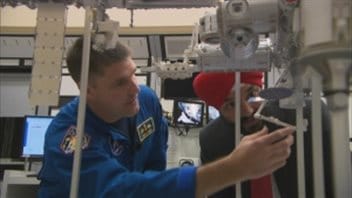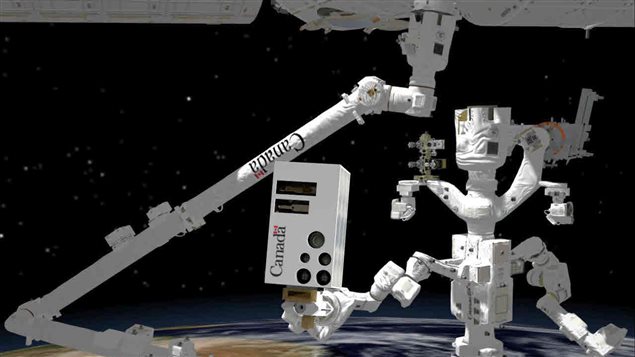Canada will be sending a set of high-tech eyes to the International Space Station in 2020 to help detect damage to the outer shell of the station from micrometeorites and space debris.
Federal Innovation Minister Navdeep Bains announced a $1.7-million contract for an advanced monitoring system for the ISS Thursday at the Canadian Space Agency (CSA) headquarters in St-Hubert, a suburb of Montreal.
“What we’re going to receive and get for this technology is the ability to survey the entire space station,” said Canadian astronaut Jeremy Hansen. “Right now we’re constantly being bombarded by micrometeorites in space, a little, tiny holes in the space station and to date we haven’t had any major problems but parts of the station have been up there for 15 years.”
(Click to listen to the interview with Canadian astronaut Jeremy Hansen)
ListenStephane Desjardins, acting director Exploration and Development at the CSA, said the contract is only the first phase of the development of a new system that will be used to inspect the space station.
The sophisticated vision system, which will be designed by Ottawa’s Neptec Design Group Ltd., includes an HD (high definition) camera, an infrared camera and also a laser system that can make 3D images, Desjardins said.
(Click to listen to the interview with Stephane Desjardins of Canadian Space Agency)
ListenThe system will be mounted on Dextre, a Canadian-built robot, attached to the end of Canadarm2, and will be used regularly to inspect the station to find if there is any small damage that could not be detected by regular cameras or by visual inspection, Desjardins said.
“Normally we use Dextre to go around the space station and do repairs but by providing this new set of eyes we can actually survey for this damage,” Hansen said. “Currently one of the only ways we can get high resolution images of areas is when astronauts happen to be out there.”

The device will contribute to greater safety on the space station by finding and detecting potential trouble spots earlier and will also reduce the time astronauts and cosmonauts have to spend outside the station, Hansen said.
“This is very exciting, this shows once again how Canada is well-positioned in those kind of technologies, and is providing expertise to make sure that the station is safe,” Desjardins said. “We’ve provided Canadarm2 that is currently and constantly being used to maintain the station, so this type of vision system will continue in the same vein.”
The system should be ready to be launched to the space station by the end of 2020.
Eventually, the technology developed by Canada can used not only in space but also on Earth for remote monitoring or inspection of objects in regions are that are difficult to access otherwise, Desjardins said.







For reasons beyond our control, and for an undetermined period of time, our comment section is now closed. However, our social networks remain open to your contributions.